I Narrowly Escaped Death at a Fugu Restaurant in Osaka
I kind of feel like Blake Lively in her opening monologue of that underwhelming 2012 action-thriller, Savages, when she stonerishly says, “Just because I’m telling you this story doesn’t mean I’m alive at the end of it. This could all be pre-recorded written and I could be talking writing to you from the bottom of the ocean.” You know, minus the Mexican Cartel, Salma Hayek (and Benicio del Toro), and strange (and steamy) sexual throuple with a Navy Seal and marijuana grower.
Fugu (aka pufferfish) is one of those foods that you hear nonchalantly condescendingly tossed around in conversation, by the likes of that one couple friend who always seems to fly Cathay business to Japan, Bali, or whatever nearby Asian destination needs to be ticked off their gastronomic checklist. It’s a delicacy. It’s divisive. It’s (allegedly) deadly.
I had to find out for myself whether a “dance with the devil” (Immortal Technique-style) was in my immediate future and decided to tempt fate. So, I threw my finest Orix Buffaloes baseball jersey and stretch-fit jeans on and headed to a fugu restaurant just 15 minutes to the west of Osaka Castle (in Osaka Japan, of course) to check it out for myself.
Read on to find out if I survived or if I’m writing this from the bottom of the ocean with Blake and Amelia Earhart. I’ll also explain what fugu actually is and why it should be on your radar should you make a trip over to Japan.
Pale Ale Travel Note: While this is a more general blog post about eating fugu in Japan, I’ve still provided details on the restaurant I ate at and what you can expect when heading there.
What Exactly is Fugu?
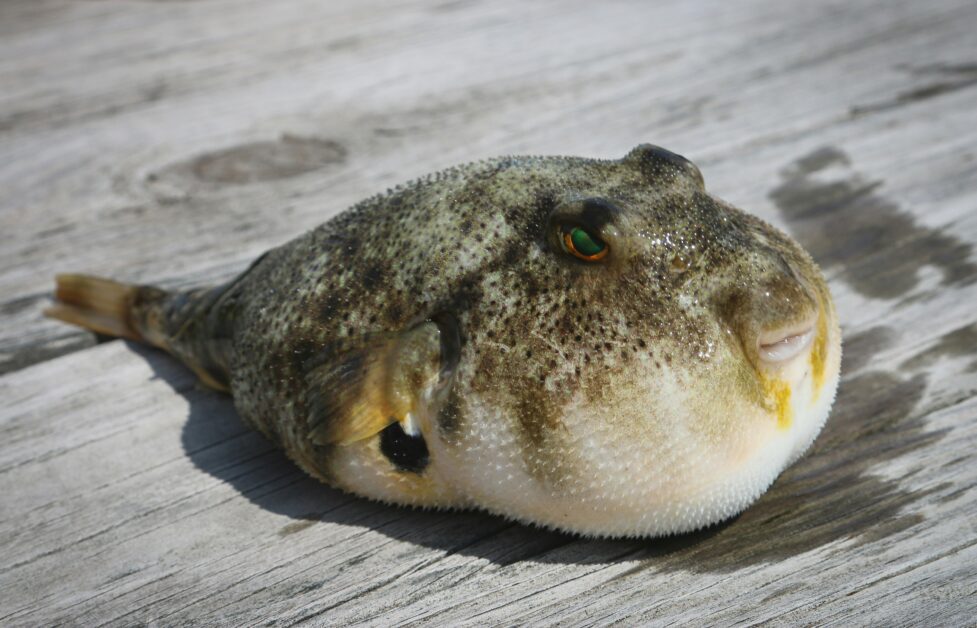
At its simplest. Fugu is pufferfish. You know that kind of goofy fish that you see that looks like it’s always trying to do Derrick Zoolander’s signature (sexy) ‘Blue Steel’ look with pursed lips and piercing eyes. The one that is essentially the porcupine of the ocean, inflating into a bulbous, prickly, ball of fury as a defense mechanism anytime it feels threatened. Like almost any sort of creature in life, humankind had a moment where they thought to themselves, “Hey, we should probably try and eat this too.” And out of this, fugu was born.
The spiky barbs (which are actually scales) that have you thinking you’re looking at some sort of medieval torture instrument are more show than anything. It’s what’s inside this fish that predators and humans should be concerned about. Pufferfish are part of the Tetraodontidae family, similar to the porcupinefish, with the overwhelming majority of pufferfish being toxic – and some being considered the most toxic vertebrae in the world.
The toxin is ‘tetrodotoxin’, a powerful and sometimes lethal neurotoxin, which is an estimated 1200 times more powerful than cyanide. I really hope nothing suspicious happens to any of my loved ones as my Google searches of well-known deadly chemicals and their lethality compared to tetrodotoxin would not bode well for me in an interrogation.
Tetrodotoxin is primarily found in the internal organs of the pufferfish, with the liver, ovaries, and eyes sporting the highest concentrations, and sometimes the skin. What’s especially grim about tetrodotoxin poisoning is that the unsuspecting diner will slip into a state of paralysis where they are fully conscious but unable to breathe – ultimately passing away due to asphyxiation.
Further, there’s no known antidote to combat this so the only real hope of survival is to empty your stomach and consume activated charcoal to remove the unabsorbed toxin.

This guy is reflecting on why he tried to prepare fugu at home instead of just going to a restaurant where it’s expertly prepared.
To be fair, more than a handful of 400-pound-plus customers of the Heart Attack Grill in Las Vegas have abruptly passed away after consuming an unholy abundance of lard-soaked burgers (patrons over 350 pounds eat for free) and “Flatliner Fries.” The fact that you don’t have to get publicly weighed on a Rhinoceros-sized industrial scale before eating fugu surely points to it being a far more dignified death (should that statistical improbability occur).
In the pufferfish species that are served for human consumption in Japan, the liver and other internal organs (and sometimes the skin) are methodically removed and prepared. When I used the term ‘deadly’ above, I used it incredibly liberally. Further, the tetrodotoxin, aka the ‘poison’, found in fugu has (for the most part) been bred out of the fish with each generation.
Finally, in Japan, only chefs who have three or more years of rigorous training and handling qualifications are allowed to prepare fugu, so you’re in safe hands. You’re not going in for a Brazilian Butt Lift and getting one of those back alley plastic surgeons who has a degree in paralegal studies from the non-accredited, now defunct Everest College.
How Likely Am I to Die From Eating Fugu?
Alright. Now that I’ve definitely scared you away from ever eating fugu, let’s dig into why you’re statistically more likely to be struck by lightning than killed by fugu poisoning prepared by a licensed, trained, and highly regulated chef in Japan.
An estimated zero to six people (out of a population of 125 million-plus) die of fugu poisoning in Japan each year. From my understanding, the majority of these deaths occur when average people take the risk and attempt to prepare it at home.
Keep in mind that there were only 10 fatal shark attacks in 2023 alone, which was considered a record number and double the previous year. Lightning strikes, on average, kill 28 people per year in the United States. Further, the beloved Asian glutinous rice cake, mochi, kills roughly 1,300 people per year (this is primarily associated with asphyxiation amongst the elderly). But I’m sure that didn’t stop you from eating it at Lunar New Year.
While there’s a non-zero chance of dying from eating fugu, there’s also a much higher likelihood of you dying and winning a Darwin Award in the process – like the time I thought I’d scrape my tongue with a water bottle cap and almost choked to death.
P.S. Depending on what statistics you go by, there may even be a higher chance of you being killed from a vending machine in your lifetime than from eating fugu.
Pale Ale Travel Note: While fugu is also served in both Korea and China, this post is based on fugu preparation and consumption in Japan and the same standards, regulations, and foresight may not apply when eating fugu there. I feel like that’s an important caveat so I don’t have a random reader’s family and/or estate trying to collect from me after a mishap eating fugu in a different country.
The Plentiful Amalgamations of Fugu
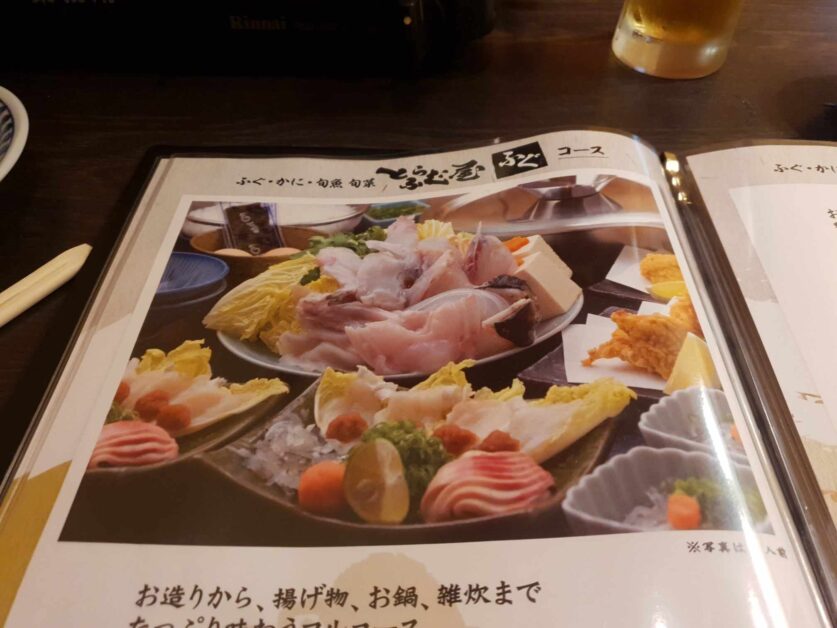
After several failed attempts to enter during previous weeks, I swung by right at the restaurant’s opening to make a reservation for later that night and was given the good news. I would compare the fugu restaurant (Ike-fugu Torafuguya) I went to as more of an izakaya-esque type of spot. It was cozy, dimly lit, and sported no more than 20 seats throughout the entire place.
Website, Address, & Details: https://torafuguya.foodre.jp
- Name: Ike-fugu Torafuguya
- Location: 2 Chome-2-12 Uchihiranomachi, Chuo Ward, Osaka, 540-0037, Japan
- Price: $$-$$$
I couldn’t pass up the ‘nomihoudai’ – all-you-can-drink deals – that is famous throughout Japan and opted for an all-you-can-drink premium fugu set. I had no idea what this entailed as I still hadn’t downloaded Google Lens at that point in my stay but found most of the dishes to be easily discernible based on their look and preparation.
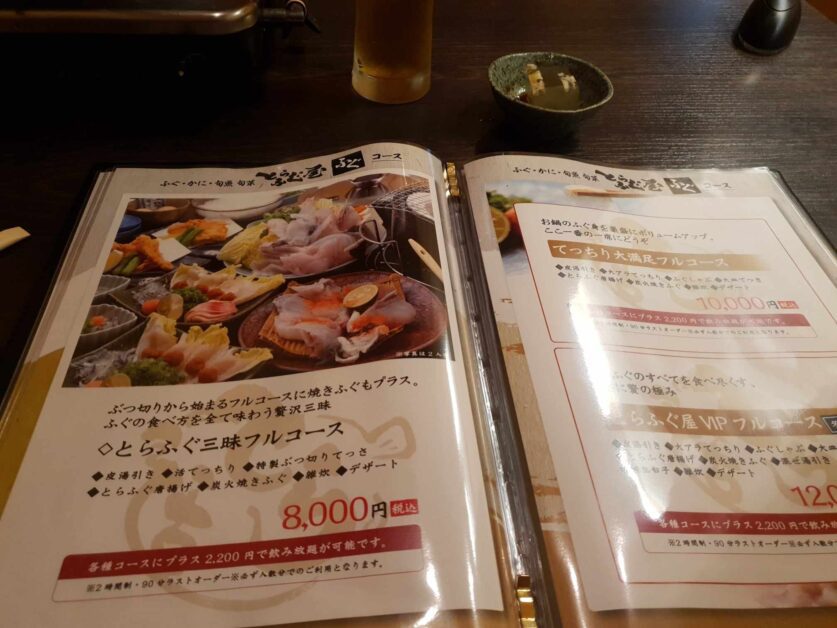
The total cost of the premium fugu set cost just over 8,000 yen (USD 55). I added on the nomihoudai (all-you-can-drink) for 2,200 yen (USD 15) extra and then threw in several rounds of crab croquettes (which emphatically were the best version of any croquette I’ve eaten in my life), so my bill was closer to 12,000 yen (USD 80).
From my understanding, most quality fugu restaurants will run you anywhere from 10,000 to 30,000 yen (USD 70 to 200).
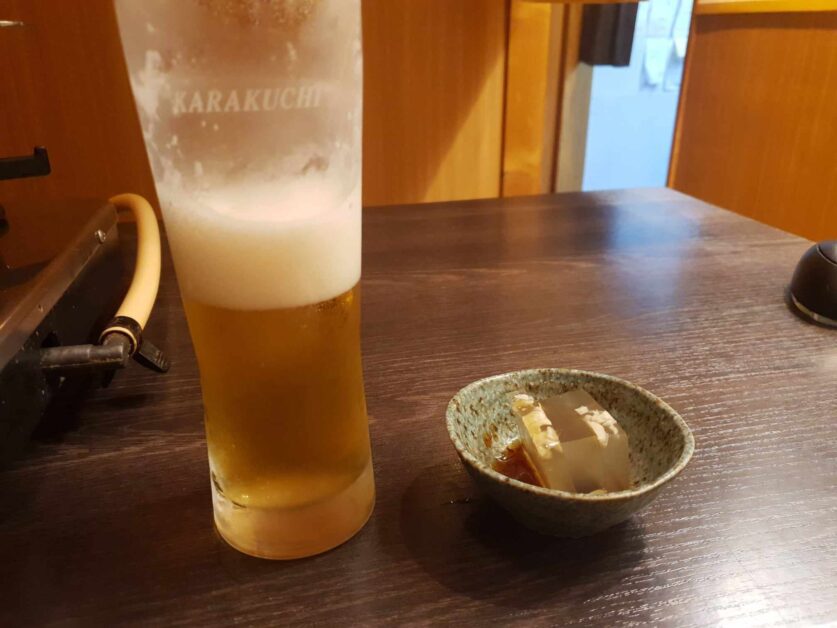
Before we even get into the “official dishes” that were brought out, I was given a small bowl with a gelatinous cube known as ‘nikogori’ – boiled fugu bones, tail, head, and other parts that amalgamate into a savory jelly.
I didn’t realize the depth and variety of ways you can prepare fugu. I thought it would just be strictly a sashimi-type of dish. While fugu is most popularly served sashimi-style, you can also find fugu karaage (fried) and fugu stew (nabemono), along with fugu as an addition or “infuser” in salads, sake, and other popular Japanese dishes.
Pale Ale Travel: I do think a missed marketing opportunity for the American hip hop apparel company ‘FUBU’ is in regards to dressing people for burial after death by fugu. The clothing line could just simply be referred to as ‘FUGU’ (all capital letters are key) with a picture of a pufferfish in a dark hooded cloak holding a scythe.
Here’s what my premium fugu set included:
Parboiled Fugu Sashimi Skin
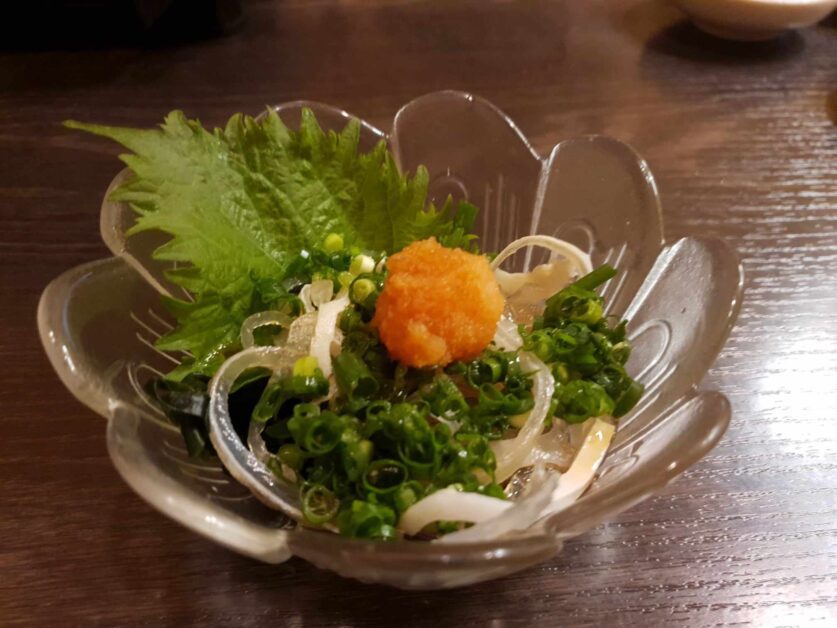
For some reason, I thought that the fugu in question was going to make a grand entrance, like Hannibal Lecter when he’s wheeled in, strapped to a gurney with a repurposed hockey goalie’s mask covering his chompers. After all, it’s a delicacy and I naively thought that it was a “special occasion” type of food – like when you take your uncle to a teppanyaki grill in Columbus Ohio to cheer him up after he’s served with divorce papers by his second wife.
So, I didn’t even realize that the aforementioned nikogori (gelatinous cube) and thin translucent chewy strips before me were actually the official start of my fugu feast. Now, I’m someone who enjoys chicken cartilage and likes a good crunch when you bite in, so this was quite enjoyable for me. However, if you’re expecting a soft, silky Vietnamese glass noodle texture with a little give and snap, I assure you that’s not going to be the case at all.
The sashimi skin salad is parboiled, meaning it is only partially cooked by boiling. This is in furtherance of tenderizing the fugu ‘meat’ yet enabling it to retain a slightly chewy, not overly rubbery texture. However, it’s far more rubberband than “egg noodle” in texture and generates an audible snap when biting in. What does help break it down ever so slightly is the acidity from the citrus-based ponzu sauce at the bottom of the dish.
It was garnished with an orange dollop of what I first thought was tobiko (flying fish roe) but after biting in realized it was a slightly sweet and refreshing bite (rather than briny) – making me think it was in fact daikon oroshi (grated Japanese radish). This mainly acted as a conduit to absorb more of the acidic ponzu for an otherwise mild-flavored dish.
Fugu Sashimi Platter
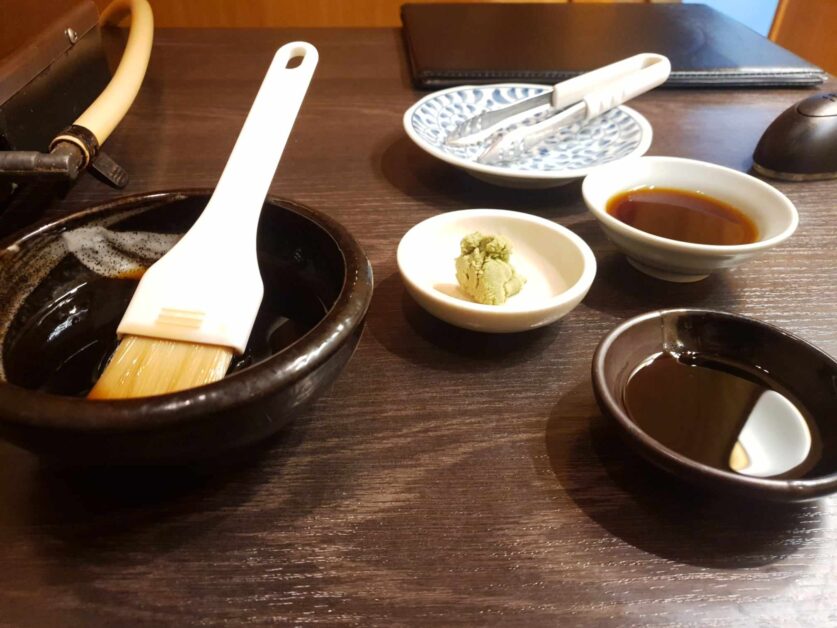
You can see that they provided me with a ‘basting’ station, which I became very familiar with throughout the course of the meal. It included a sweetened teriyaki soy sauce, ponzu sauce (a citrusy, dashi-infused soy sauce that combines sweet, salty, and sour all into one), and wasabi. I have no doubt in my mind that I gave some fellow Japanese patrons heart attacks with how I iconoclastically stirred my wasabi into the soy sauce in front of me.
There are several reasons behind the brush and various sauces. First, it allows diners to customize the intensity of flavors and cut through any particular dish they aren’t a fan of. And second, because of the thin slicing of the fugu, constantly needing to dip it into a specific sauce can be cumbersome and messy.
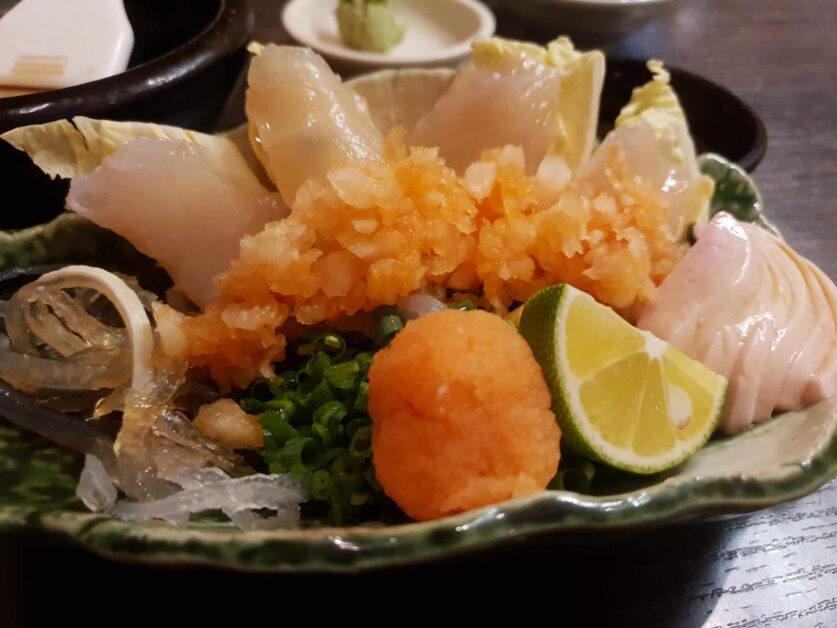
You’ll also note the fugu sashimi skin included in this sashimi platter.
We aren’t talking just any regular pufferfish at this restaurant, we’re talking ‘torafugu’ (aka Takifugu rubripes, aka tiger pufferfish) – which is considered one of the most sought-after, edible species of pufferfish and the most poisonous. This is also the most common fugu and because of its cost per kilogram (1,000 to 4,000 yen), it requires deliberate carving by the chef in order to maximize the amount of meat rendered.
It’s also sliced with a dedicated knife, the ‘fugu hiki’, which is stored separately from other kitchen utensils (for good reason).
The thicker slices in the back with a tinge of pink are the hirami, which is the most reminiscent of fan favorites like flounder or sea bass. After crunching my way through the fugu sashimi skin, I was caught off guard by just how tender and delicate the hirami was (which is actually how properly prepared fugu should be). It sports a clean, fresh flavor with a subtle sweetness and almost melt-in-your-mouth profile.

The pinker creamy slices in the right of the picture are the milt (shirako), also known as the sperm sac. It has an almost custard-like texture that is considered ‘luxurious’ and is relatively smooth on the palate. Maybe a comparison to a soft tofu might be more apt. There’s a hint of sweetness that doesn’t overpower and contrasts nicely with the citrusy lime and refreshing daikon oroshi.
I don’t know why but just looking at the milt and knowing what it is, I suspected it would be far brinier but it really just is an overall smooth cut with a mild oceanic flavor.
Fugu Karaage
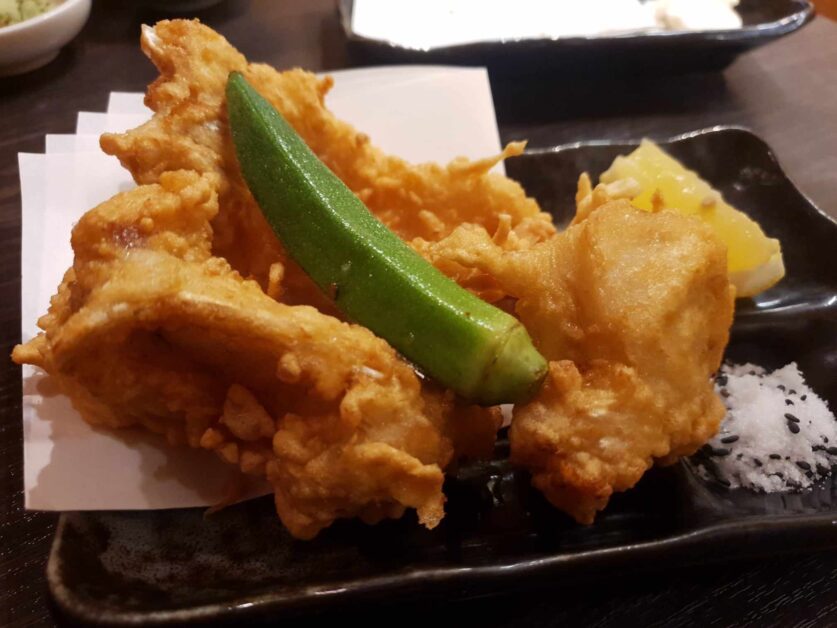
I’m not entirely sure why it was garnished with okra.
Before moving to Japan for three months, I thought karaage only referred to fried chicken. However, if you’ve read my post on the time I ate horse meat in Osaka, then you’ll know that one of the variations I really enjoyed was horse karaage. The point is, if it’s meat, you can bet your bottom dollar it can also be karaage (deep fried in oil).
While fugu karaage wouldn’t be the bachelorette I give my final karaage rose to, it’s still golden fried fish and pretty damn tasty. The only thing that really slows you down while eating it is the skeleton/spine, which is composed of collagen and a bit oddly shaped.
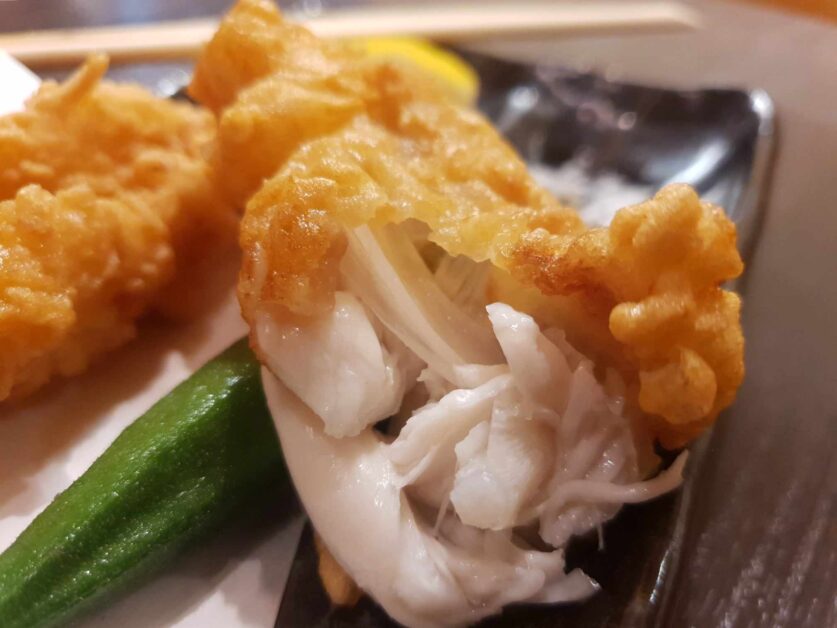
I’d compare fugu karaage’s taste more to a traditional fish and chips type of cod due to its mild sweetness (you must be seeing a theme here with the flavor of fugu). However, fugu isn’t flaky and the meat clings to the spine far more like a traditional fried chicken wing, which had me hunched over, elbows on the table like a Buffalo Wild Wings regular.
The tenderness and juiciness of fugu meat worked well in contrast to the crunchy, caramelized exterior, which added further depth to what I thought was just going to be “expensive fish and chips.”
Grilled Fugu (G.Y.O.F.)
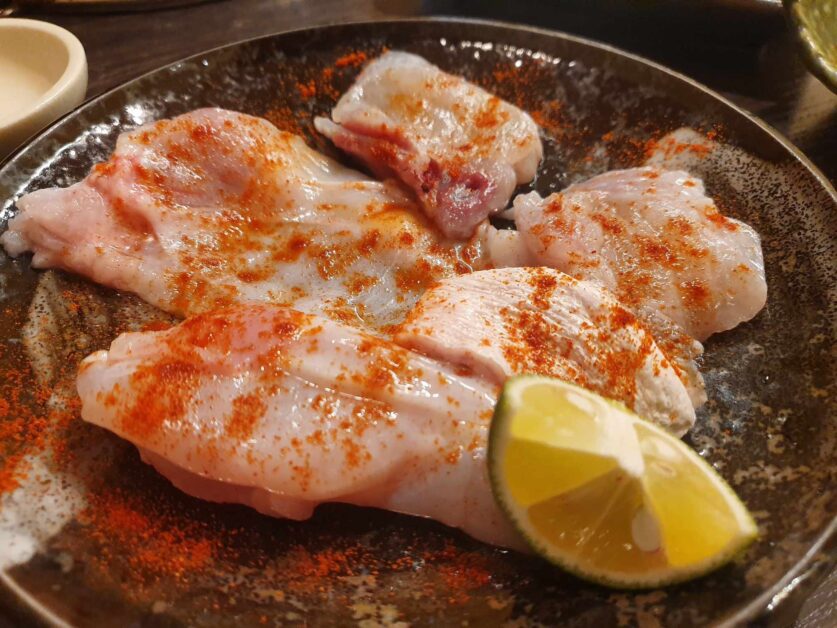
G.Y.O.F. – Grill Your Own Fugu.
Sumibiyaki (charcoal grilled) fugu was the form that I was the most uneasy about as I really had zero idea how long I was supposed to cook it on my personal grill. After Google Translating with my extremely kind and patient waitress, she let me know that it was good to pull off the grill once it turned white. She explained that it was ‘hire’, which is fugu filet, and was actually more similar to grilling meat at a yakiniku (BBQ) restaurant.
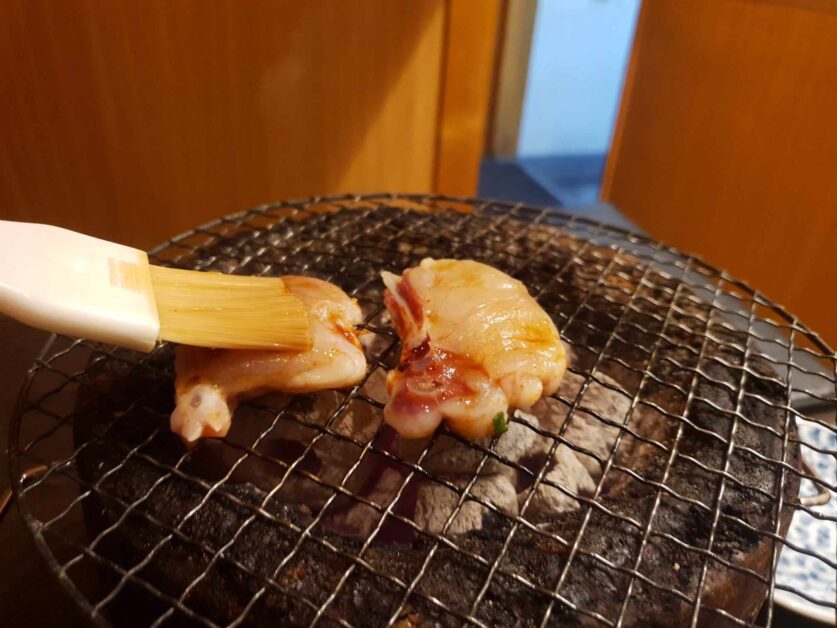
I should have labeled this picture ‘X-rated’ as that’s one sexy basting.
What I especially loved about this fugu iteration was that I was able to lather this up with copious amounts of sweet and savory soy sauce to create a nice little caramelized shell around it. By this point, I had realized that drawing out the natural sweetness of the fugu was the play. The hint of smokiness from the coals was an added bonus.
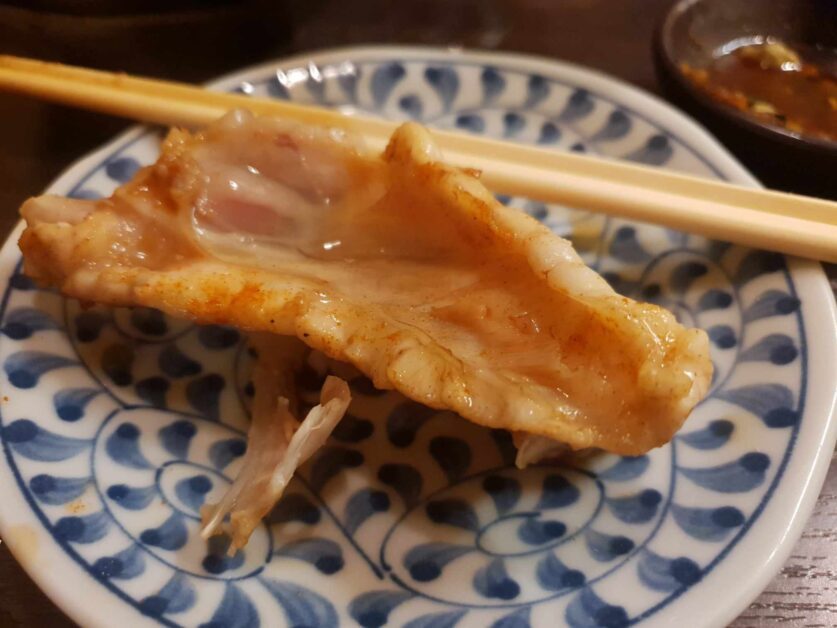
This may be an odd comparison but it very much reminded me of several Shanghainese bullfrog dishes I’ve really enjoyed in the past due to the girth and meatiness of the non-fibrous filets.
Fugu Nabemono (Fugu Hotpot)
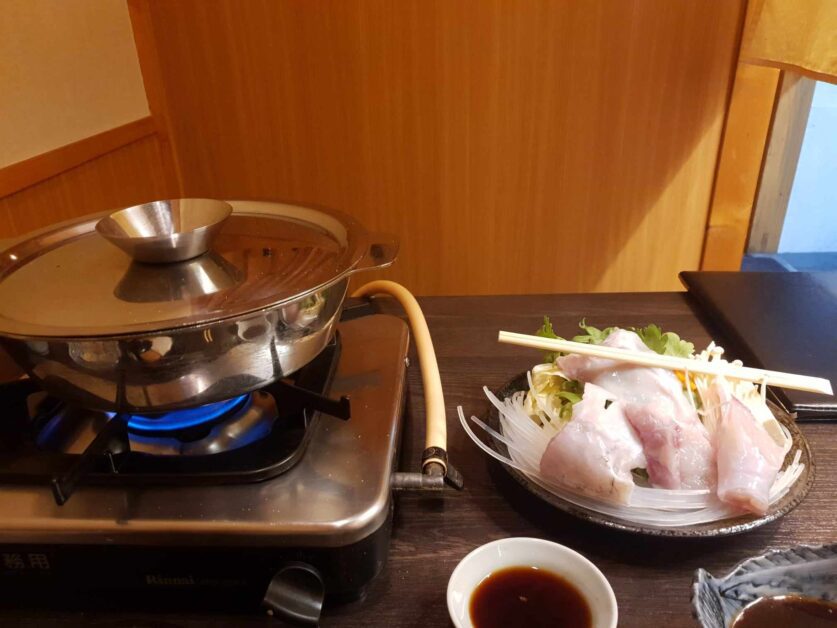
Fugu nabemono (hotpot) is served at the end of the meal to cleanse the palate and utilize leftover ingredients to minimize waste. It’s also typically a communal activity and offers up a hearty, soul-warming finish to the meal (which progresses from cold to hot and light to heavier).
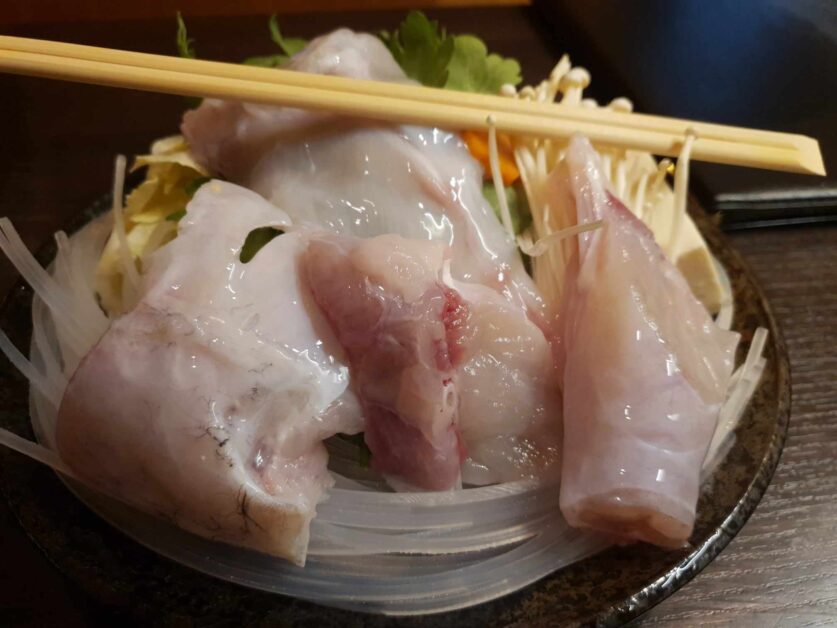
I felt like one of those sumo wrestlers bulking with chankonabe – a variation of nabemono and beloved hotpot dish eaten in massive quantities featuring mushrooms, tofu, konjac noodles, and napa cabbage.
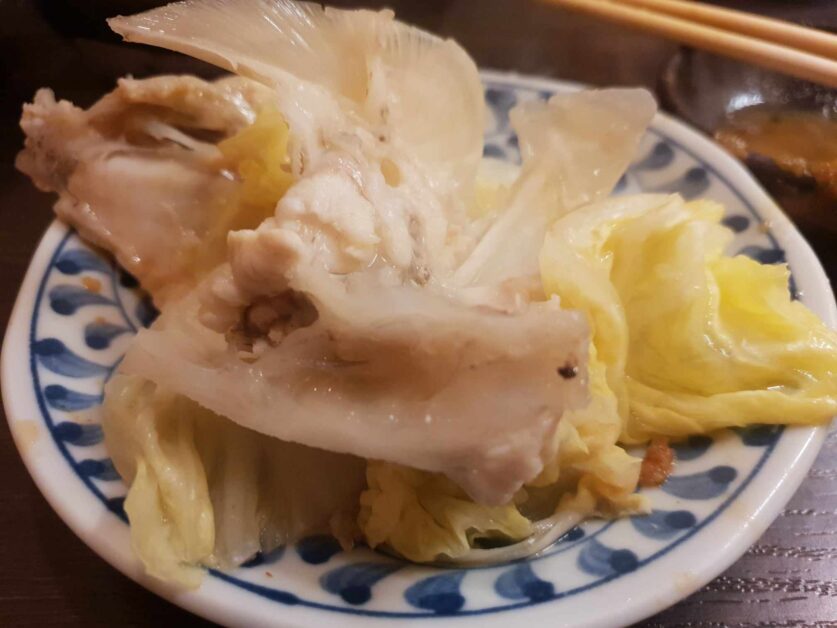
This may have been the highlight of the meal right here. While I can’t say there was anything too enthralling about boiling the sizable fugu hunks (I definitely prefer them grilled or fried), it’s what my waitress did halfway through that had me ready to commit myself to a life of only fugu. She poured cooked rice into the remaining broth (which only became more flavorful as time elapsed) and gently stirred in an egg to create a simmering fugu porridge.
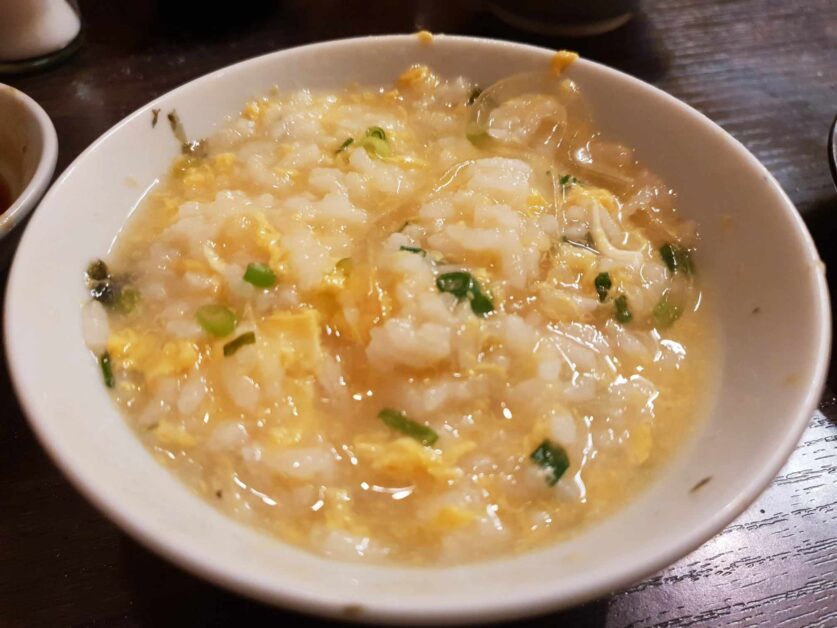
The naturally flavored vegetable broth (flavored with dashi) provided a rich and savory foundation to the porridge, which was only elevated by the creamy velvety texture of the stirred-in eggs. What particularly stands out to me with nabemono is the sweetness of the Napa cabbage, which becomes more pronounced the longer it simmers.
After having “broken down” the vegetables with prolonged cooking, the rice further added textural contrast and body by absorbing the best parts of all its constituents. The fugu really didn’t come into play too much in this dish other than imparting some of its mild sweetness into the broth, as I’m not sure anyone wants to be digging into a bony porridge.
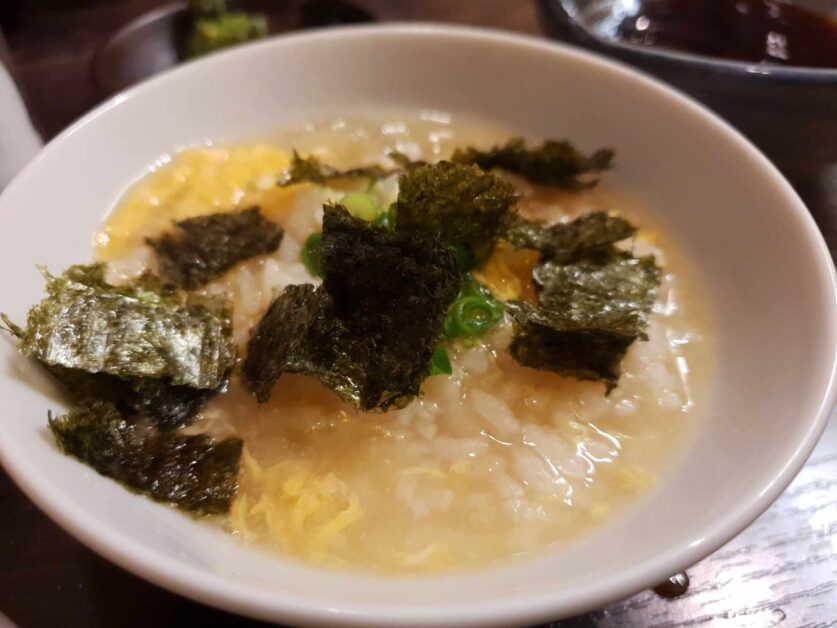
However, a light sprinkling of nori imparted some of that sea-like flavor that was missing.
Crab Croquettes
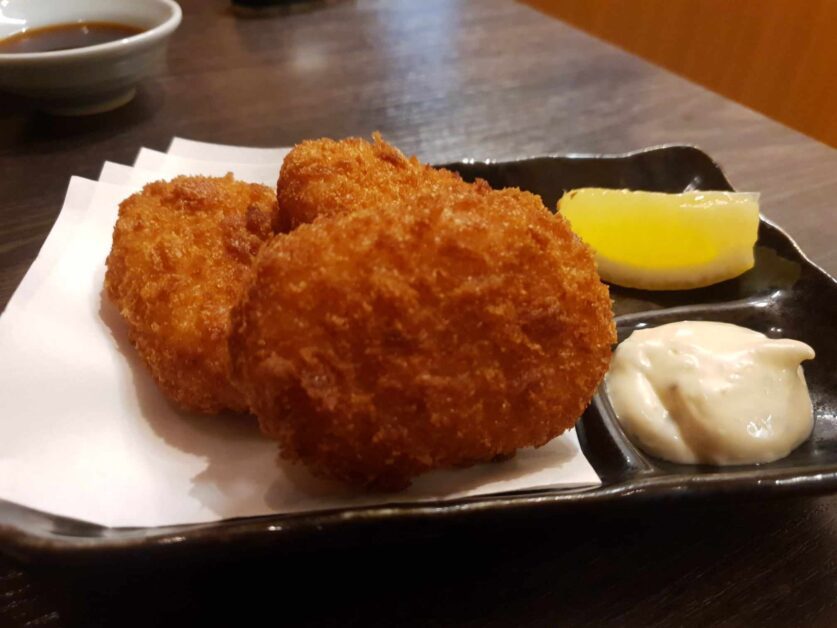
The creaminess of the crab filling (which I think was created with a bechamel sauce) and the addition of silky mashed potatoes took these croquettes to unprecedented gastronomic heights. Usually, croquettes are a side dish to complement a main but if you served these to me and called it a meal, I would not complain one bit.
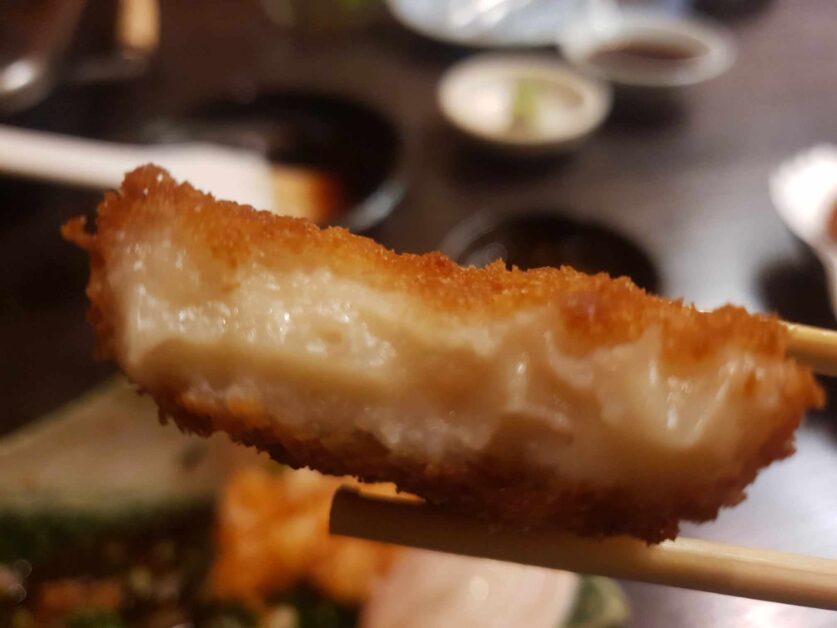
They almost reminded me of if you took the cream of mushroom from a green bean casserole (a traditional Thanksgiving dish in the U.S.) and deep fried it in a light shell. Crispy, fried, creamy bliss.
I can’t emphasize enough that for the amount of fugu (and croquettes) and nama beerus (draft beers) I consumed, this was an incredibly reasonably priced meal.
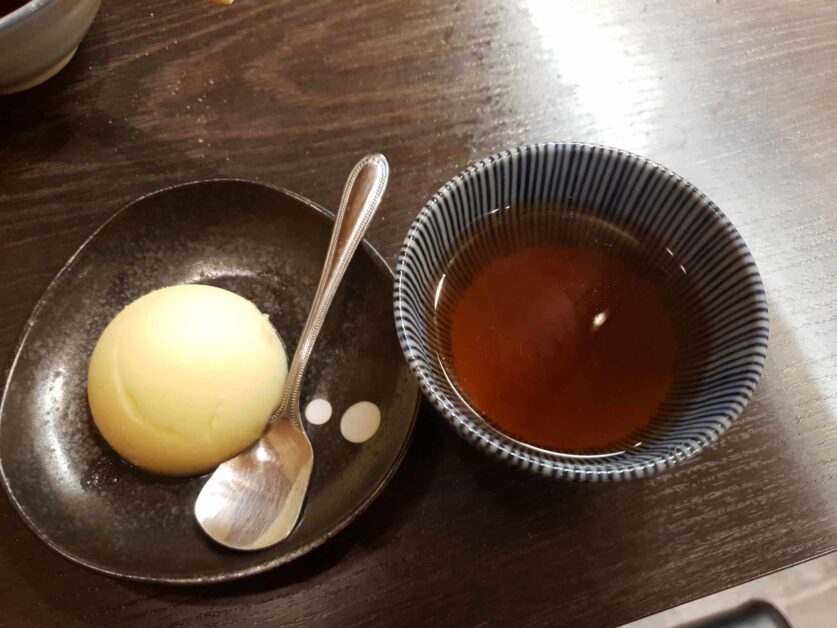
Oh, and it was even finished off with ice cream. However, I don’t think there was any fugu used in making it.
Should You Try Fugu in Japan?
If you’ve drafted a will, phoned your loved ones, and picked out the song they carry your casket out to at your wake (mine is definitely going to be ‘Jump’ by Van Halen), then go for it. I’m just kidding. You should absolutely try fugu if you want to experience a unique culinary experience and delicacy prepared by trained professionals that is celebrated across Japan.
Should you be procuring your own pufferfish and trying to cook it at home for a dinner party? Absolutely not – unless they are your in-laws. That was morbid and I’m just kidding – I don’t want anyone ending up as a suspect on 48 Hours.
Luckily, almost every Japanese city should have at least one or more fugu restaurants so if you do decide you want to try it, it’s definitely within arm’s reach. In Osaka, I pinned roughly 9 or 10 fugu spots that I wanted to try and only ended up making it to two of them.
Pale Ale Travel Tip: If you’re in the Kansai Region and are looking for something a bit more familiar, make sure to check out my post breaking down 21 of my favorite ramen restaurants in Osaka.
Will I Ever Eat Fugu Again?
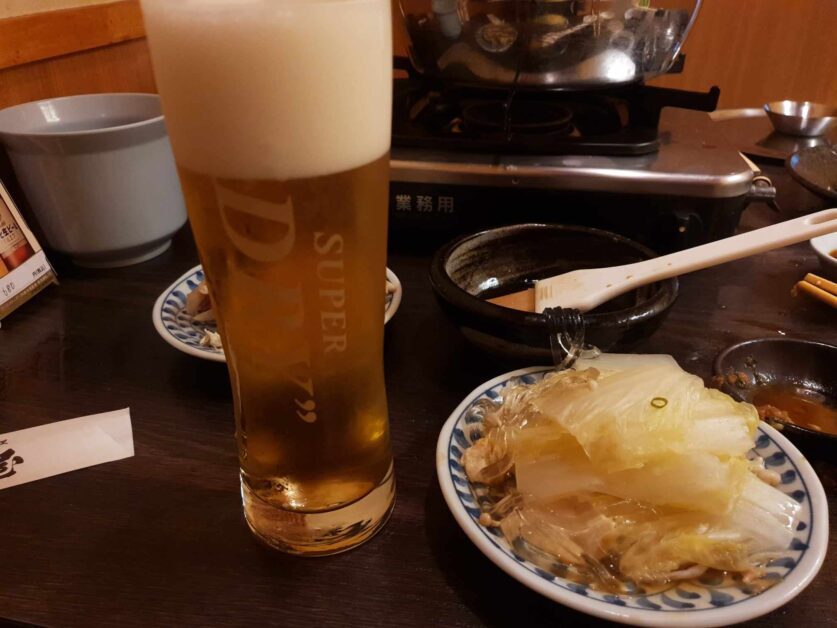
First, I think we need to circle back to answer if I actually made it and am above ground to learn if I’m even capable of eating fugu again. The good news is that I’m not Bruce Willis in The Sixth Sense. I’m alive. If you’ve already seen Savages then you already knew that. However, I’m not in a hot person throuple living out in a beachside hut in Indonesia like in the movie. Sad, I know.
Now, would I ever eat it again?
Probably. It’s damn delicious. I know that some people refer to this as “thrill-seeking” but I would rank this on the general safer side when it comes to extreme living. After all, your pufferfish is prepared by a trained professional, the preparation and licensing process is strictly controlled and handled, and the fish you’re eating may never have actually been poisonous.
Would it be something that I regularly eat and mix into my Yoshinoya and Coke Zero diet? Probably not because I’m on a Yoshinoya budget and am not made of money. However, it was one of the most memorable culinary experiences I’ve had in my thirty-three years on this planet – only next to failing the Buffalo Wild Wings ‘Blazin’ Challenge’ as a sophomore in university.
My brother did work at Buffalo Wild Wings for several years after university and gave me a free ‘Blazin’ Challenge’ winners t-shirt which I wore around for subsequent years, masquerading as a wing-eating champion. Stolen chicken wing valor.
If you’ve eaten fugu in Japan, I’d love to hear from you in the comments. What was your favorite variation of it and would you ever try it again? Further, if you have any questions about traveling to Japan, don’t hesitate to reach out to me via email (info@palealetravel.com).
Eat well everyone,
Big Body
Big Body is a voracious lov…eater, a cowardly fighter, and a self-proclaimed curry goat BBQ-eating champion (don’t forget the donkey milk) who likes Stoicism, baseball, and writing in the third person. Having worked for himself for the last 7 years, he isn’t particularly successful but he does still drink ice-cold Sapporo draft beers with the best of them and knows his way around a Dai Pai Dong or two. He is based in Hong Kong but you can still find him in Saigon, Osaka, and Vienna for extended periods.
